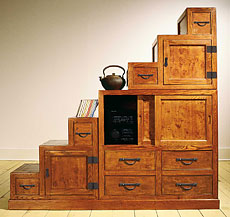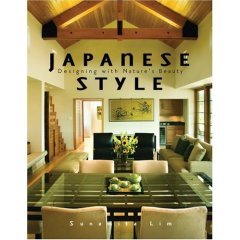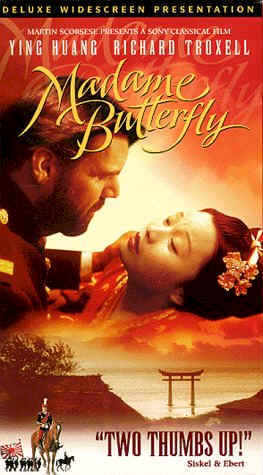 A
Tansu Tribute, August 16, 2004 A
Tansu Tribute, August 16, 2004
Reviewer: The
Rebecca Review
If you are fascinated by the creation of handmade Japanese
cabinetry, this is one of the few books you can find on the
subject because for some reason, the cabinetry of Japan is one
of the least recorded aspects of Japan's woodworking history.
Throughout this guide, you will find lush photographs of opaque
and transparent lacquered chests, their hand-forged iron handles
and the tools of the trade. I especially enjoyed the
hand-colored photos of family life, rice fields and the textile
sellers. Not only do you get to glimpse this magical world of
Zen temples and street merchants selling sweet rice drinks, you
will be able to view page after page of stunning merchant
chests, bedding chests, clothing chests and mizuya-dansu
(kitchen cupboards).
I've always been intrigued by chests filled with magical little
drawers in which anything could be stored. This book has made me
aware of the wide variety of chests that can be purchased and
most of the pages are filled with pictures and descriptions so
you can know what to look for online. Before finding this
particular book, I was at a loss for what to look for. Now I
have the names of items like the sea chest (funa-dansu) and
realize the difference in the woods used. I think the cho-dansu
made of keyaki with the distinctive iron fittings on page 111 is
just stunning. The cho-bako funa-dansu (ship chest) is also very
interesting as it features tortoise, a symbol of prosperity and
longevity.
The detailed descriptions of the lockplates are presented with
photographs. If you are a student of this craft (or looking for
pictures of things like a cherry blossom motif), the pages on
the components of a tansu will encourage you to explore all the
essential details in your own selections. They also explain how
all the L braces and iron-edge strapping are not only
decorative, but highly functional.
As a person who has refinished a desk upon which I am typing, my
appreciation for furniture went through an entire renewal
process while reading "Japanese Cabinetry."
Contents:
The Realm of Tansu: An Introduction
Tansu and Allied Trades
The Craft of Tansu
Tansu for Mercantile Use
Tansu for Household Use
Tansu for Personal Use
Living with Tansu
Collecting and Restoring Tansu
Not only does this book present early mercantile tansu designs,
there are pictures of contemporary desks and even a section
about books, magazines and catalogues for further research. The
index, glossary of terms and chronological list of exhibitions
make this book very easy to read and understand. There are also
ideas for how to set up your tansu collection in your bedrooms,
bathrooms, living rooms and kitchen. You might even want to put
a kitchen chest (mizuya) in your living room. This book also
features entry tables, entertainment centers, coffee tables and
bookcases and so much more.
Back to dreaming of owning the cho-dansu from the late Edo
period (1615-1868). Not only can you view items from this
period, you can read about the history and lifestyle of the
people living in this era. This book would make a perfect gift
for anyone who has lived in Japan or is interested in Japanese
history. It would also be an amazing gift for anyone interested
in Japanese movies. I have often wondered about various items
and this book has provided more information than I could have
ever dreamed about finding.
A note about the authors: David Jackson has been collecting
tansu since 1990 and has studied sculpture and woodworking. He
developed his passion for Japanese woodwork and then was
involved with one of the first exhibitions of tansu in the
United States. Dane Owen founded a gallery of Japanese antique
furnishings and is also a frequent visitor to Japan. He can be
found searching for objects for his customers and his own
private collections. Together they have written the ultimate
book on the Japanese craft of tansu. If you love tansu, your
heart is going to beat a little faster while reading Japanese
Cabinetry. I am beyond appreciative of David and Dane's
knowledge of this subject. If you buy one book on tansu, this
would be an excellent choice.
~The Rebecca Review
Green Tea Designs

www.greenteadesign.com
"All our Step Tansu are two-sided, so
that when used as a room divider you can
access the drawers and doors from either side. Most also consist
of a main
cabinet with two step pieces - making them easy to move
and
easy to set up in different ways."

Japanese Style
 Zen Sanctuary
Zen Sanctuary, October 11, 2007
"The Japanese garden rearranges the natural landscape in
order to create a new beauty from nature." ~ Hirotaro Ota
After reading Sunamita Lim's beautiful book: "Chinese
Style," I was interested to know more about her new book:
"Japanese Style." It is equally impressive with warm
nurturing spaces created with wood and bamboo. While reading it
is easy to imagine yourself wandering along stone pathways or
sitting by a pond in a serene Japanese garden.
"Simple celebrations of everyday life can be as easy as
kicking off your shoes at the front door to symbolize leaving
behind the harried outer world, then lighting incense and being
soothed by the subtle aroma of lavender wafting through the
house." ~ pg. 76
I was intrigued by some of the designs, especially the cabinet
made with maple, alder and burl woods. The bamboo gate leading
out into a garden also looked inviting. While the gardens are
filled with beautiful fountains and stone lanterns, the
interiors are filled with soft fabrics, pillows and
interestingly patterned rugs.
The teahouses are especially warm and inviting and Sunamita
Lim's beautiful writing sets a mood for the traditional
settings. This is the type of book you want to read while
sitting in a comfy chair. Half the enjoyment is reading the
well-placed quotes and imagining living in a refreshingly pure
and soothing environment.
~The Rebecca Review

Madame
Butterfly
"Madame Butterfly" is an exquisite and
faithful cinematic adaptation of Giacomo Puccini's Opera "Madama
Butterfly" set in Japan in 1904. It is really a
heart-wrenching story of a young geisha who sacrifices her
religion, family and life with a more suitable partner, like
Prince Yamadori, while she waits for Lieutenant Pinkerton to
return. One of my favorite movies of all time!
|